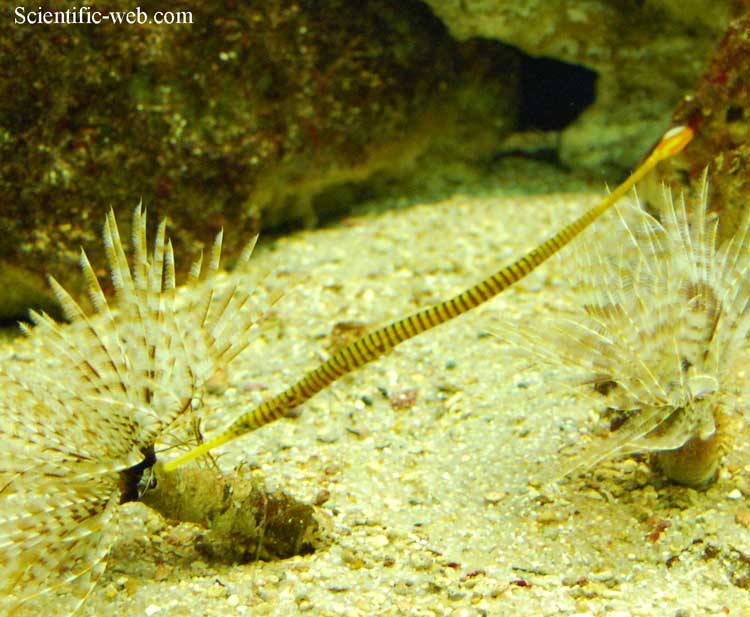
Dunckerocampus dactyliophorus, Photo: Michael Lahanas
Superregnum: Eukaryota
Cladus: Unikonta
Cladus: Opisthokonta
Cladus: Holozoa
Regnum: Animalia
Subregnum: Eumetazoa
Cladus: Bilateria
Cladus: Nephrozoa
Superphylum: Deuterostomia
Phylum: Chordata
Subphylum: Vertebrata
Infraphylum: Gnathostomata
Megaclassis: Osteichthyes
Superclassis/Classis: Actinopterygii
Classis/Subclassis: Actinopteri
Subclassis/Infraclassis: Neopterygii
Infraclassis: Teleostei
Megacohors: Osteoglossocephalai
Supercohors: Clupeocephala
Cohors: Euteleosteomorpha
Subcohors: Neoteleostei
Infracohors: Eurypterygia
Sectio: Ctenosquamata
Subsectio: Acanthomorphata
Divisio/Superordo: Acanthopterygii
Ordo: Syngnathiformes
Subordo: Syngnathoidei
Familia: Syngnathidae
Genus: Dunckerocampus dactyliophorus
The banded pipefish or ringed pipefish (Dunckerocampus dactyliophorus) is a species of fish in the Syngnathidae (seahorses and pipefish) family.[3][2]
Distribution and habitat
The banded pipefish is widespread throughout the tropical waters of the Indo-Pacific region, Red Sea included.[2] Its range includes Australia, Fiji, French Polynesia, Indonesia, Japan, the Marshall Islands, New Caledonia, Northern Mariana Islands, Papua New Guinea, the Philippines, Samoa, the Solomon Islands, South Africa, and Taiwan.[1] It inhabits tide pools, lagoons, and outer reef slopes in tropical climates.[2]
Description
The banded pipefish has a straight, elongated body which reaches a maximum length of 19 cm (7.4 in).[2] It has fleshy streams coming back from its head. These trails are thought to be mechanisms of camouflage for the pipefish whilst hiding in reeds.[4]
Reproduction
Similar to the other seahorses and pipefishes, the male banded pipefish is equipped with a specialised brood pouch, rather than the female.[5] The female deposits her eggs in the male's pouch, where they develop. The male later gives birth.[6]
References
Pollom, R. (2017) [errata version of 2016 assessment]. "Dunckerocampus dactyliophorus". IUCN Red List of Threatened Species. 2016: e.T6814A115083653. doi:10.2305/IUCN.UK.2016-3.RLTS.T6814A67621462.en.
Froese, Rainer; Pauly, Daniel (eds.) (2015). "Dunckerocampus dactyliophorus" in FishBase. October 2015 version.
"Fish.gov.au". Archived from the original on 22 July 2008. Retrieved 10 July 2008.
Günter Berghaus (2004). New Perspectives on Prehistoric Art. Greenwood Publishing Group. p. 42. ISBN 978-0-275-97813-6.
Marshall Cavendish Corporation, ed. (2004). Encyclopedia of the Aquatic World. Marshall Cavendish. ISBN 978-0-7614-7418-0.
Blasiola, George C.; Matthew M. Vriends (2000). The Saltwater Aquarium Handbook. Barron's Educational Series. ISBN 978-0-7641-1241-6.
Retrieved from "http://en.wikipedia.org/"
All text is available under the terms of the GNU Free Documentation License

